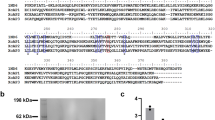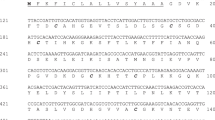Abstract
Androgen-binding protein (ABP) is found in the salivas of a wide variety of rodents and it has been proposed that ABP functions in sex and/or subspecies recognition (Karn and Dlouhy,J. Hered. 82, 453, 1991). This is a report of significant identity between the alpha subunit of mouse salivary ABP and Chain 1 of cat allergen Fel dI (50% identity), as well as with two other proteins that share identity with Chain 1 of Fel dI, rabbit uteroglobin (27% identity with ABP alpha) and human lung Clara 10 (27% identity with ABP alpha). The secondary structure predicted for the mouse ABP alpha subunit is a very good fit with the secondary structure determined by X-ray crystallography for rabbit uteroglobin, a protein that shares with mouse ABP the capability of binding steroid. Fel dI is found in cat saliva, sebaceous glands, and pelt. Its function is not known but it has been proposed to be involved in protecting dry epithelia, a parallel to uteroglobin protecting wet epithelia. Since mice, like cats, lick themselves and each other extensively, coating their pelts with ABP may be part of this or another biological function.
Similar content being viewed by others
References
Beato, M., and Baier, R. (1975). Binding of progesterone to the proteins of the uterine luminal fluid. Identification of uteroglobin as the binding protein.Biochim. Biophys. Acta 392346.
Bond, J. F., Brauer, A. W., Segal, D. B., Nault, A. K., Rogers, B. L., and Kuo, M.-C. (1993). Native and recombinantFel I as probes into the relationship of allergen structure to human IgE immunoreactivity.Mol. Immunol. 301529.
Chou, P. Y., and Fasman, G. D. (1978). Prediction of the secondary structure of proteins from their amino acid sequence.Adv. Enzymol. 4745.
Dlouhy, S. R., Nichols, W. C., and Karn, R. C. (1986). Production of an antibody to mouse salivary androgen binding protein (ABP) and its use in identifying a prostate protein produced by a gene distinct from Abp.Biochem. Genet. 24743.
Dlouhy, S. R., Taylor, B. A., and Karn, R. C. (1987). The genes for mouse salivary androgen-binding protein (ABP) subunits alpha and gamma are located on chromosome 7.Genetics 115535.
Garnier, J., Osguthorpe, D. J., and Robson, B. (1978). Analysis of the accuracy and implications of simple methods for predicting the secondary structure of globular proteins.J. Mol. Biol. 12097.
Griffith, I. J., Craig, S., Pollock, J., Yu, X.-B., Morgenstern, J. P., and Rogers, B. L. (1992). Expression and genomic structure of the genes encoding FdI, the major allergen from the domestic cat.Gene 113263.
Karn, R. C. (1991). Genetic control of mammalian salivary proteins. In Ferguson, D. B. (ed.),Aspects of Oral Molecular Biology, Vol. 8. Frontiers in Oral Biology S. Karger, Basel, pp. 117–140.
Karn, R. C., and Dlouhy, S. R. (1991). Salivary androgen-binding protein variation inMus and other rodents.J. Hered. 82453.
Karn, R. C., and Russell, R. (1993). The amino acid sequence of the alpha subunit of mouse salivary androgen-binding protein (ABP), with a comparison to the partial sequence of the beta subunit and to other ligand-binding proteins.Biochem. Genet. 31307.
Kyte, J., and Doolittle, R. F. (1982). A simple method for displaying the hydropathic character of a protein.J. Mol. Biol. 157105.
Morgenstern, J. P., Griffith, I. J., Brauer, A. W., Rogers, B. L., Bond, J. F., Chapman, M. D., and Kuo, M.-C. (1991). Amino acid sequence of Fel dI, the major allergen of the domestic cat: Protein sequence analysis and cDNA cloning.Proc. Natl. Acad. Sci. USA 889690.
Mornon, J. P., Fridlansky, F., Bally, R., and Milgrom, E. (1980). X-ray crystallographic analysis of a progesterone-binding protein. The C222(1) crystal form of oxidized uteroglobin at 2–2 A resolution.J. Mol. Biol. 137415.
Rose, G. D. (1978). Prediction of chain turns in globular proteins on a hydrophobic basis.Nature 272586.
Singh, G., Katyal, S. L., Brown, W. E., Phillips, S., Kennedy, A. L., Anthony, J., and Squeglia, N. Amino-acid and cDNA nucleotide sequences of human Clara cell 10 kDa protein. (1988).Biochim. Biophys. Acta 950329.
Author information
Authors and Affiliations
Rights and permissions
About this article
Cite this article
Karn, R.C. The mouse salivary androgen-binding protein (ABP) alpha subunit closely resembles chain 1 of the cat allergen Fel dI. Biochem Genet 32, 271–277 (1994). https://doi.org/10.1007/BF00555830
Received:
Revised:
Issue Date:
DOI: https://doi.org/10.1007/BF00555830




